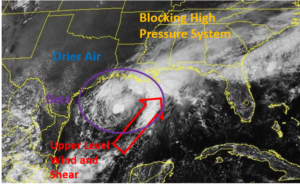A broad area of low pressure was over the southwestern Gulf of Mexico on Sunday afternoon. The system was designated as Invest 92L. At 2:00 p.m. EDT on Sunday the center of Invest 92L was located at latitude 20.0°N and longitude 96.0°W which put it about 100 miles (160 km) north-northeast of Veracruz, Mexico. The area of low pressure was nearly stationary. The maximum sustained wind speed was 25 m.p.h. (40 km/h) and there were wind gusts to 35 m.p.h. (55 km/h). The minimum surface pressure was 1010 mb.
The broad area of low pressure exhibited a little more organization on Sunday afternoon. There was an apparent low level center located north-northeast of Veracruz, Mexico. However, there were few thunderstorms near the apparent center. Most of the thunderstorms were occurring far to the east and north of the apparent center. Some of the stronger winds were occurring in the thunderstorms far to the east and north of that center.
Invest 92L is likely to remain over the southwestern Gulf of Mexico during the next several days. The broad area of low pressure will be in an area somewhat favorable for the development of a tropical depression. Invest 92L will be over an area where the Sea Surface Temperatures are near 29°C. It will be under the northern part of an upper level ridge centered south of Mexico. The ridge will produce westerly winds which will blow across the top of the broad low pressure system. The westerly winds will cause moderate vertical wind shear, which will inhibit the formation of a tropical depression. The upper level ridge could move a little farther north in two or three days, which would cause the westerly winds to weaken. If that happens, then the conditions could become more favorable for the formation of a tropical depression. The National Hurricane Center is indicating that the probability is 50% that a tropical depression forms during the next five days.

